Loading and Moving Big Logs with Minimal Impact
This starts out as a conversation about block and tackle mechanical advantage, but develops into a detailed and useful discussion of ways to skid and load logs without tearing up the woods or lot. June 18, 2010
Question
When loading logs, I back load them on my trailer using a double par buckle attached to a snatch block, through which the winch cable passes on its way back to the front of the trailer. I understand that a snatch block can 1/2 the load to the winch as long as it is doubled back 180 degrees (double line pull), but what has me scratching my head is how to calculate the amount of mechanical advantage when using a par buckle. Does anyone know how to calculate this?
Also, I'm finding that I could get some really great logs (and big) from some landowners if I can remove the logs without disturbing their property (no trucks, 4x4s or other heavy equipment). I have been thinking of a type of arch that would lift the log entirely with a third wheel up front and the ability to be towed by a winch. Anyone have suggestions regarding this?
Forum Responses
(Sawing and Drying Forum)
From contributor S:
Block and tackle gives you a mechanical advantage equal to the number of lines for dead lift/pull. And I think you get an advantage from any ramp involved, which in essence is another machine.
From contributor M:
Other than helicopter removal, about the only other means I know of to skid logs with minimal forest floor damage is draft mules or draft horses. There will be some disturbance of course, but a lot less than skidders, dozers, etc. Not a job for amateurs, however. Both handlers and animals need to be experienced, especially on slopes or close quarters. Don't know if a log arch can be used with draft animals. Downslope braking may then be a problem.
From contributor G:
"...the amount of mechanical advantage when using a par buckle."
2:1
From the original questioner:
Contributor G, of course... Par buckle behaves like a double line pull with the log acting like a snatch block. Thank you. I use a double par buckle (one on each side of the log). Does this reduce the load to the snatch block that attaches to the winch line? I use 2 for stability, but it would be good to know if a second par buckle line adds to the mechanical advantage.
Contributor S, yes, rolling a log (even uphill) requires much less force than picking it up. Which raises another question: What is the amount of force required to roll an object (say, a 3000 lb log), assuming that the log is straight and round and the ground is level and flat. Also, as the ground inclines up a ramp, is there a way to figure the amount of increased force required relative to the angle of incline?
Contributor M, thanks for that suggestion. No helicopter, though I can think of 100 uses for one. Draft horses would be ideal except that I don't own any, though I did work with draft horses some when I was a kid.
Let me mention why this is a problem worth solving for me. In one case, some folks a few miles from me have five or six very large and healthy black locust (all well over 30"dbh, straight and mostly clear to about 18') at the back of their property that they would like me to take down. All logs and firewood are mine if I can extract them without tearing up the yard. Another fellow has a 2 acre pure stand of walnut. He'd like me to thin out some of the larger ones and will let me have the logs and firewood if I can do it without making a skidway though his property. I could go on...
I sell some air-dried, I give some lumber to my neighbors and the church here in town, but mostly I saw for myself. Sawing for me is more leisure activity than profession, so time spent getting great logs is time well spent. I will try to post a sketch of the arch design I'm thinking about and hopefully you can provide a little feedback. Thanks for everyone's help.
From contributor B:
You can use a standard man powered logging arch like the ones in Bailey's catalog. We bought the LogRite Fetching Arch and nothing could be lower impact. We got it with both the two man handle and the towing tongue and winch. I think this rig maxes out at 28 inches diameter. It is also a good tool for loading a trailer.
From the original questioner:
Thanks for the input. The trouble for me is that most of the logs I'd be getting are well over 30"dbh and between 3000 and 4000 lbs. Also, the Logrite arches are designed for either human or machine pull... I need something that can be line pulled. Besides, if there's something on the market that could work for me, I certainly can't afford it. And to make matters worse, I need to engineer something that one person can operate. I'm hoping some wise Woodwebbers have built something similar. I have the know-how to put it together just as soon as I know what it is.
From contributor S:
Have you thought about an arch like a propane tank hauler? Towable with an ATV? Perhaps you could borrow one from a local gas company. (Trade them boards?) Some states even allow you to transport the log on the highway with them. (Not mine, though.)
From contributor M:
I should probably shut up about horses, but there may be someone in your area that does that. If you live in a northern state, the best time to skid is in the winter when the ground is frozen and snow-covered. Easier on the horses and the ground. And yes, they do use log arches with horses and mules.
From contributor N:
The more wheels you have on the ground, the more you distribute the weight. If there's room to get a 4 wheeler and multi axle trailer in there, it seems you will do less damage than an arch. I've considered building a powered arch for situations like this when there is limited access and the ground is firm enough. How about moving in a swing mill?
From contributor J:
I built an arch with a tackle block attached to it, run the cable from an 8000 lb. winch hooked to the tractor, and then use a tong to hook the log. I then pick one end of the log right up, keeping most of the dirt out of it. I have a 30 hp 4x4 tractor. I have been able to haul just about any size log.
From the original questioner:
Here is a rough sketch of what I had in mind, adding contributor N's excellent 4 wheel idea. It seems more complicated than it needs to be, but I'm asking quite a bit from one piece of machinery. It needs to be able to handle the largest log I'm likely to encounter, it needs to be line-driven, it needs to fit in my truck, and it needs to be easy for one man to operate. Any and all ideas are welcome.
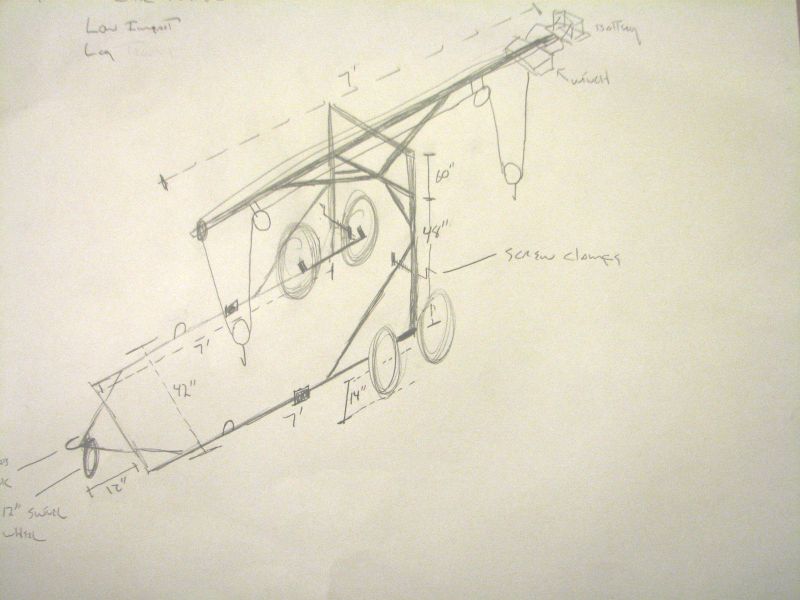
Click here for higher quality, full size image
Contributor N, thanks for the valuable input. You're right about more wheels having better weight distribution. As for motorizing it, I think it's a great idea... maybe chain driven from a winch motor? But I'm getting ahead of myself. I still need to figure out a workable design.
Contributor J, I look forward to seeing your setup... Sounds you know what you're doing!
Contributor M, I have many photos of small teams of horses standing in front of an impossibly huge load of logs, but the photos I have of a skidding operation in progress always show 10-12 horses pulling just a fraction of these monster loads. I always had my suspicions. Can they actually pull those loads?
From contributor I:
I have been down this road skidding with an ATV. The arch should have 4 wheels. Two per side on a walking beam. There should be a hoop or half circle to join the wheels; this will be sized to your largest log. From the top of the hoop is where you attach your pole hitch so it clears the log, but when you are turning, the log is picked up and carried so the only disturbance is from the ATV. The other option is a system of blocks and a long cable. Build a steel cone to go over the end of the log and deflect it off of obstacles with the cable coming through the middle of the cone. You can then use blocks with a strap around various trees to pull your logs out. Very labor intensive system, though.
From contributor D:
To the original questioner: Your design looks almost identical to the propane tank hauler mentioned earlier. But you show a screw about halfway up the uprights. This won't work as it will introduce too much spreading force on the frame and cause it to fail. The screws, unless they're very large, will also likely bend during use. And maintaining purchase will be a crapshoot. They are not necessary. Instead, simply chain the log to the top rail at the front and rear.
Alternately, you can use two skidding arches to completely lift the log off the ground. This is done by pulling the first unit, tongue first, over the rear of the log. Lift the tongue high, then fasten the arch to the log. The tongue is then pulled down and fastened to the log. This will completely lift the rear. The second unit is rigged as normal to the front of the log, but the winch cable is attached to its tongue. When the cable is tightened it will pull the tongue down on the front unit and the log will be completely lifted off of the ground. The front unit's steering ability will be maintained, i.e., it will steer in the direction of the pull. Ground clearance won't be much, so high humps and long logs could be a bad combo.
From contributor T:
This is the arch that I built and use. It will handle a large log with a four-wheeler, lawn mower, truck or, as in the photo, a small tractor. This white oak was 8' long and 30" on the small end. Just the other day I moved a 24" X 29" cedar with no destruction of my neighbor's yard. My mill is stationary and the arch is wide enough and tall enough to back over my mill and set the log down.
I also use it to turn large logs on the mill. The lifting mechanism is a Hy Lift jack rated at 7k.
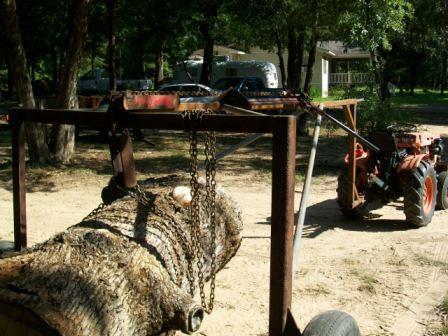
Click here for higher quality, full size image
From the original questioner:
I knew I could count on you guys to help me out! Thanks for the great input.
Contributor I, what is a walking beam? Is it similar to the 7' horizontal sections in the sketch? I'm trying to imagine the type of machine this is... Like one of the larger Logrite arches? Does it use a log grapple at the center? I don't have an ATV, so can it be line pulled? I'm sorry I can't visualize it better. It sounds much simpler than what I drew out. I have done block and cable before, skidding over plywood so as not to tear things up. That's why I'm hoping to built a smarter tool.
Contributor D, I talked to Ferrel Gas yesterday about buying an old propane tank hauler as was suggested. When I finally got to the right person, he said that none were for sale, so they don't have any old or non-working ones, and no, they are never auctioned off. Did I mention that he was not very friendly?
You are right about the screw clamps. Too much lateral motion will just tear them up. On the horizontal side rails I sketched in two U bolts for straps, thinking this may also help minimize movement. But now that I'm thinking about it, it would simply increase the downward pressure on the frame. I like the idea of chaining the log to the top. Will that minimize lateral movement? How about an adjustable steel plate mounted just underneath the 1st horizontal support bar? If I winch it up snug to that plate, would that work just as well to keep the log in place? The tandem log arches are a great idea and much simpler, except that I can't afford to buy two large arches. And you're right about terrain and log length posing a problem. I'll have to think about that.
Contributor T, that's a great system. Looks like you can handle some big wood with that. Also, I really like the versatility of your machine. I would have never thought to use a log trolley to load and turn on the mill. Does your system lift the log at one or two points? Do you have any problems with the log moving around in transit?
From contributor M:
Yup, those old photos are real, but I'm sure the really huge loads were drawn over quite level ground. Displays at the Adirondack Museum at Blue Mountain Lake, NY show the whole history. They even used water wagons to create ice troughs for the runners to run in. Going uphill, that would require a lot more real horsepower.
From contributor T:
It lifts on one point only. I usually pick up the log a little front heavy and use a ratchet strap to hold the front end of the log up.
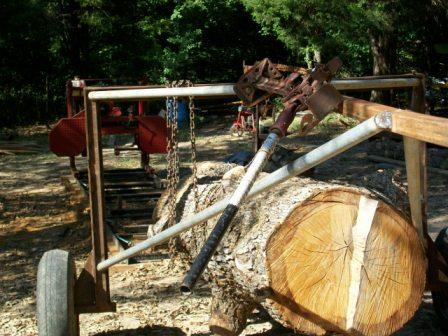
Click here for higher quality, full size image
From contributor K:
I just came across an Old Northern tool catalog that has some figures from Warn winch. To figure angle of ramps they have a triangle with 3 sides - A, B, C. A is the height, B is the distance, and C is the angle percentage.
The formula they show is to figure grade; A divided by B = C.
The examples show a Warn 1700 winch is: 8668 lbs at 11* grade, 3304lbs at 31* grade, and 2404 lbs at 45* grade. And Warn 4700 winch is 23965 lbs at 11*, 9185 at 31* and 6647 lbs at 45*.
I parbuckle my logs too. My trailer tires pretty much follow my truck tires. I don't think I could do any less damage to the yard by pulling trailer with a cable to high ground vs keeping it hooked to the truck.
From the original questioner:
Thanks for that. I have scoured the web trying to find some info on how to figure how the amount of force to move a log changes with regard to the angle of incline, without any luck. Also, I cannot find a formula that will help me figure the percent of force required to roll a log as opposed to lift it. The figures you found are a great start.
I agree about the low impact of a truck and trailer, but often I can't get my truck and trailer to the log. And even if I could, people generally won't let me do it, and I can't blame them.
I'll go back to the drawing board armed with everyone's excellent advice and see if I can't come up with something simpler.
From contributor R:
I used a 1/2'' steel cable that was 200 feet long that I used to drag logs out of the woods to the road. I hooked the cable to my truck that was on the road and I would pull maybe 25 to 50 or so feet and back up a foot or so, unhook cable, get back into truck and back up to where I started and rehook cable and do that until the tree was along the side of the road. I used a 6000lb 4 X 3/4 ton truck and it would pull some big trees out of the woods. The 1/2 cable would break sometimes, but to repair it I would just tie a knot and it's good to go again.
From the original questioner:
For the logs I have in mind, that is not an option. If somebody made a skidway through my property, they'd sure as hell be paying for the damage. Pulling out of the woods or through a construction site would probably be fine, but not alongside people's homes, flower beds or vegetable gardens. Let me emphasize that I am trying to figure out a low impact way to extract some of these great logs.
From contributor U:
You are going to a lot of trouble on this. There are those that will say my suggestion is a lot of trouble, but it will work. Get a large tarp and spread beside the log to catch the sawdust, roll the log onto it, then saw it in place and hand carry the sawn boards to your trailer waiting in the street. This is done by us chainsawmillers all the time. Yeah, it is slow and a lot of work, but it will get the job done and boards in your shop while you are trying to figure out how to get the logs out. You will need a bar at least 4" longer than the widest log you plan to saw.
In the picture is an old Stihl 084 with a 42" bar on a 56" Alaskan mill. The log is 36" of bur oak. I also have a 52" bar that will cut 48" flitches - my "slabber." I am assuming that if you are working with big trees, you already own a big saw - 85cc or bigger.
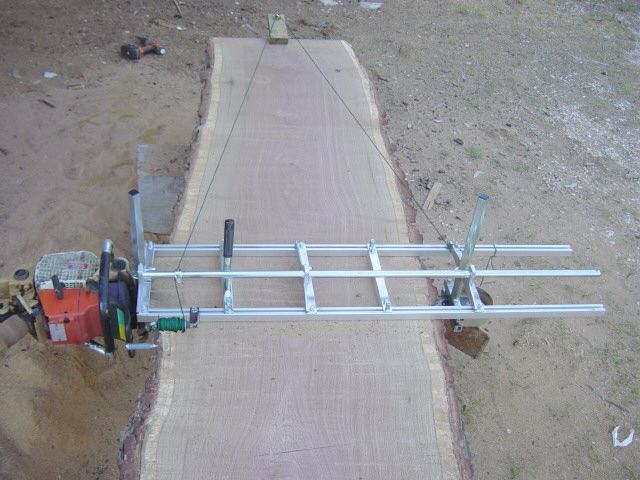
Click here for higher quality, full size image
From contributor W:
A friend built this. It works well for moving big logs and not tearing up the ground.
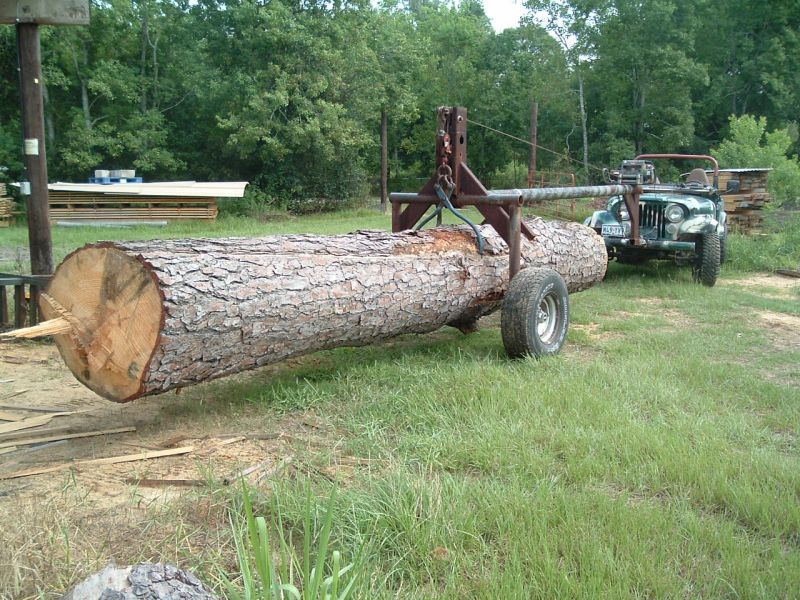
Click here for higher quality, full size image
From the original questioner:
Thanks. You're right, I am going through a lot of trouble. But I'm hoping to save myself a lot of trouble in the future. I have thought about using a CSM to saw the logs into cants and resaw on the BSM, but that opens up a new set of problems (such as handling the 12"X12" cants, sawing them up quickly, etc.). It would certainly work, and I may wind up doing exactly that if I can't come up with some low impact tool that gets the logs out in one piece.
The photo you show has what looks like a cable attached to the mill frame running to a pulley. That is a great labor saving idea... Could you explain how that works exactly?
Contributor W, thanks for posting that picture! I don't see any flex in the frame. It looks light enough to maneuver by hand (empty) yet built like a tank. What was the source for the tires and hubs? Do you have any specs on the frame? How big of a log do you think it can handle? Is that a hand winch or electric? Did you design it or did your friend? Have you ever had anything break on it? Sorry for all the questions, but I think with some modification, your design may be just the ticket.
From contributor U:
My main mill is a Logosol M7, so chainsaw milling is my way, and the M7 uses a crank mechanism to pull the saw through the log. I had an extra crank so I adapted it to the Alaskan mill, made a hook with a small pulley on it that catches on the far end of the log, and then tied it to the opposite end of the mill - works pretty well. This long of a mill works well with a second person on the other end and I am usually by myself, so this is what I came up with. I only use it on long cuts.
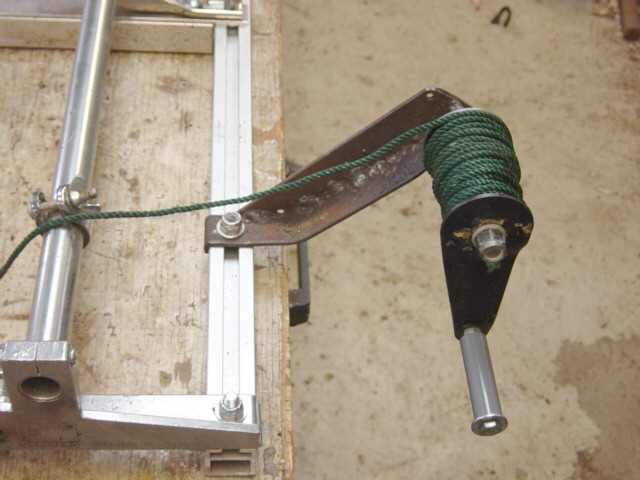
Click here for higher quality, full size image
From contributor K:
There is a book called "Chainsaw Lumbermaking" that shows a good winch setup on a chainsaw mill. Great book but it is out of print. Used copies bring big bucks on eBay.
From contributor V:
I have a portable sawmill with an electric hydraulic log lifter with two arms. I unbolted it from the mill and made it portable to be used on my trailer. Works great.
From contributor A:
I believe anything strong enough to lift a log completely clear of the ground will be too heavy for one man to carry. And if you could carry it to the log and attach and lift, the whole load would weigh the same as a car and be leaving ruts in soft ground unless you used wide high-flotation tires. The lift rig that contributor W shows works very well but is very strong and heavy, not one man movable. Can you build one like that but with a motorized wheel added to the pulling end to drive it into lifting position, then pull the whole thing out with a winch?





